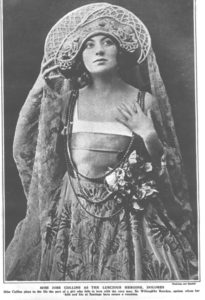Kay Garrett (b.1899): Fun and festivities
When reading Gay Garrett’s memoir you can’t help but notice that although she has gone through some hardships in her life, she never fails to have fun.
Although alcoholics, Kay’s parents made her home life pleasurable by “bring[ing] all the music hall songs” home with them “and mum would do little dances” (1). Kay goes on to say that a particular favourite in the Garrett household was Gilbert and Sullivan. Her father would sing with a “quite good light baritone voice [and] by the time I was five I knew lots of Gilbert and Sullivan choruses” (1) and she sang as a young girl in “The Festival of 5000 Voices” (2).
In a trend that began in the Victorian era, became one of the most popular forms of entertainment for working class people who could sing along to popular songs or watch exotic performers like acrobats, operatic sections or can-can dancers. These music halls originated from ‘penny gaffs’, which were the crowded back rooms of public houses where people could gain entry for a penny and sing, smoke and drink. It is probably in these rooms where Kay’s parents drank at night and stayed until around midnight.
Therefore it can be said that the music halls that were a staple of working-class entertainment helped shape Kay’s upbringing and developed a love of music. During her childhood Kay and her family also preoccupied themselves with books. She joined the Carnegie library aged seven and it was those books that got her through her illness’ and “when times were bad and Mum and Dad couldn’t go out to the pub” (1). Also, one comment that jumps out as being quintessentially working-class during the long nineteenth-century is where she states that she “never cared much for dolls and anyway we couldn’t afford toys” (1): this supports the findings that people in the nineteenth-century and at the turn of the twentieth-century made their own entertainment or looked to communal and family gatherings for fun.
This is something that occurs frequently in Kay’s life, aged 16 and working as a kitchen clerk during the First World War, she describes how she “met dozens of boys – and men – and went out with them to dances and to teas and suppers” (5). There is also a section of the memoir dedicated to the National Liberal Club’s concerts for wounded soldiers in 1916 where Kay volunteered as a server. At these concerts, held every second Sunday, “there was almost always a full orchestra; and stars of current musicals – the most famous at that time being José Collins, the star of “The Maid of the Mountains”. The fact that Kay remembers so many small details about the even and dedicates a section to it just goes to show how important community spirit was to Kay and how much it was a part of the fabric of working-class life both growing up and during her teenage years.

Then later a little later on in life, when she was living in Southern Rhodesia with her husband, mother-in-law and sister-in-law who was “a glorious musician” (7). As well as inviting friends round for musical Sunday mornings, her sister-in-law had the first jazz band in Rhodesia that played at dances, weddings and parties. When they played at gold mines and ranches, Kay used to accompany the band as a singer (7).
After reading Kay’s memoir it is clear to see how music brought so much joy to her life during some truly bleak periods.
If you want to know more about Kay Garrett’s memoirs, read previous blog posts and keep up to date with upcoming posts then follow me on Twitter
References
http://www.bl.uk/victorian-britain/articles/popular-culture
2.305 Garrett, Kay, Untitled (c.9,000 words), pp.1-12. Brunel University Library.
Extract published in J. Burnett (ed.), Destiny Obscure: Autobiographies of childhood, education and family from the 1820s to the 1920s (Allen Lane, London, 1982), pp.306-312. Brunel University Library and Ruskin College Library, Oxford.
Picture credit:
http://www.hat-archive.com/pictures%2037.htm

Leave a Reply